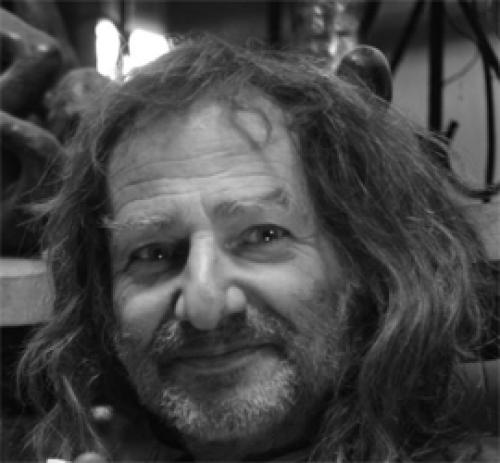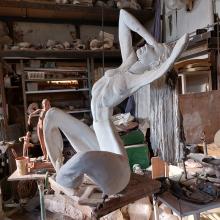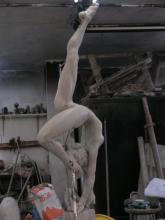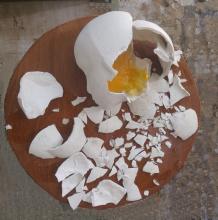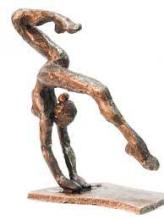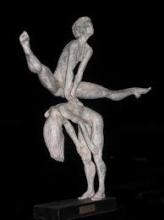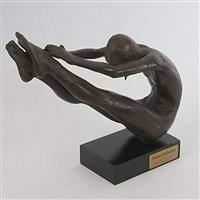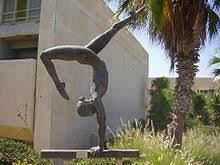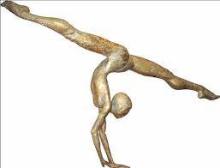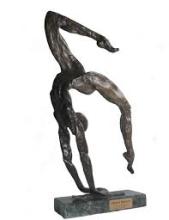Daniel Baharier, born in 1956 in London, England, is an Israeli artist and sculptor renowned for his dynamic works that explore human movement. His artistic journey began at Hertfordshire College of Art and Design, under the tutelage of John Mills and Michael Gillespie, followed by studies in sculpture at Leicester Polytechnic, University of Simone de Montfort under Sydney Harpley. In 1980, Baharier immigrated to Israel, briefly studying at Bezalel before leaving to pursue his unique artistic path.
His early works, crafted during his time working at foundries in Jerusalem and Netanya, delved into themes of human motion and physical stress, particularly in women's acrobatic movements. Baharier's service in the IDF from 1983 to 1985, where he operated the M61 Vulcan, notably influenced his subsequent artworks.
Post-military service, Baharier's artistic style evolved to incorporate mathematical formulas, producing sculptures with parallel lines and broken symmetry. His dedication to teaching art and sculpture is evident from his tenure at the School of Art Sculpture school Ascola-meimad and the Old City of Jaffa Art College, where he taught various techniques including bronze casting, mold-making, and welding.
A highlight of Baharier's career was his commission in 1994-1995 by Emilio Pellus of EDF Construction & Investments Ltd. to create 24 large-scale pieces depicting figures from the Jewish Diaspora for the Carmel Shuk 2000 project in Rishon-Le-Zion. This project, the largest of its kind in Israel at the time, showcased his ability to capture historical and cultural narratives through sculpture.
His portfolio is diverse, including collaborations with British artist Michelle Baharier and sculptures for the Tel Aviv Museum of Art, Assaf Harofeh Hospital, and the Wingate Institute. His works are featured in various locations globally, including Tokyo, London, New York, and Paris, and are part of private collections, including those of MK Meir Shitrit, a Cabinet Minister in Israel.
Currently, Baharier maintains his workshop on the border of Jaffa and Tel Aviv. He continues to create large-scale sports sculptures at the Wingate Institute and personal pieces inspired by themes like Alice in Wonderland, reflecting on a friend of his daughter's who tragically passed away from a drug overdose.
Baharier's artistry, deeply rooted in the exploration of human form and movement, along with his innovative use of materials and techniques, marks him as a significant figure in contemporary sculpture.
The Artist's Statement;
"The mediums I work in are the most plastic of the sculpture lexicon. Microcrystalline wax for maquettes, which is like working with room-temperature bronze, is so alive. It needs no preplanned metal armature and can be moulded in the hand, turned around and around, allowing you to see your visualization from all possible angles and views as you broadcast the image from your mind to your hands, forming the wax in 3D.
From here, I go to natural clay or plaster. I am at home with both and often find myself cursing the fact I am working in one, always reminding myself the other would have been easier. However, both are rich in possibilities, creating textures of different hardness and softness according to how you pack the material and whether it's wetter or drier, soft or hard, burnished or filed.
Inspiration comes from many places. I have created a whole series of sculptures based around mathematical theorems — symmetry, parallel lines, and a Mobius strip. But even with these, parts of their metamorphosis owe to branches, plants, and cracks in the paving stones at our feet, or of water — the shapes it makes as it first crawls along. I marry this with what I want to say. Within this, the process of work has on occasions led me by the nose. This includes working with wax from flat sheets and the painted images on ancient Greek vases, realizing them as three-dimensional “reliefs”, and also making moulds where I turn a positive image into a negative one. From an outcrop to a depression, I have long been attracted to the moment of equilibrium between balance and falling and strive to capture this moment to show movement within my sculptures.
I sculpt and draw because I need and love to create, especially using all those things that mummy wouldn’t let you play with, like mud, knives, and fire. As I bend the steel rods to create the armatures, I am captured in some strange place, not of this time and place. As I continue to create, I feel like I am the only focus within an unfocused world, working on a sculpture, taking a piece of clay from the bin which is exactly the shape needed to fit into the 50,000-piece jigsaw.
Being socially aware, my subject matter can be about things I feel deeply about, from peace and the fate of peacemakers to the place of women within our society and the way they are treated. From 'Me Too' at the beginning of my career through to my latest works dealing with abuse and violence towards women, I ensure not to take away the aesthetic values of the human body. For where would we be without the appreciation of a woman’s body, long a favorite theme of the artist? Above a particular message that inspired the piece, I wish to broadcast to the observers this love and care through using the composition, movement, and textures that I have achieved within each piece."

